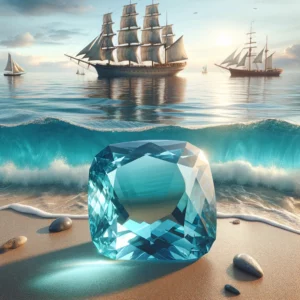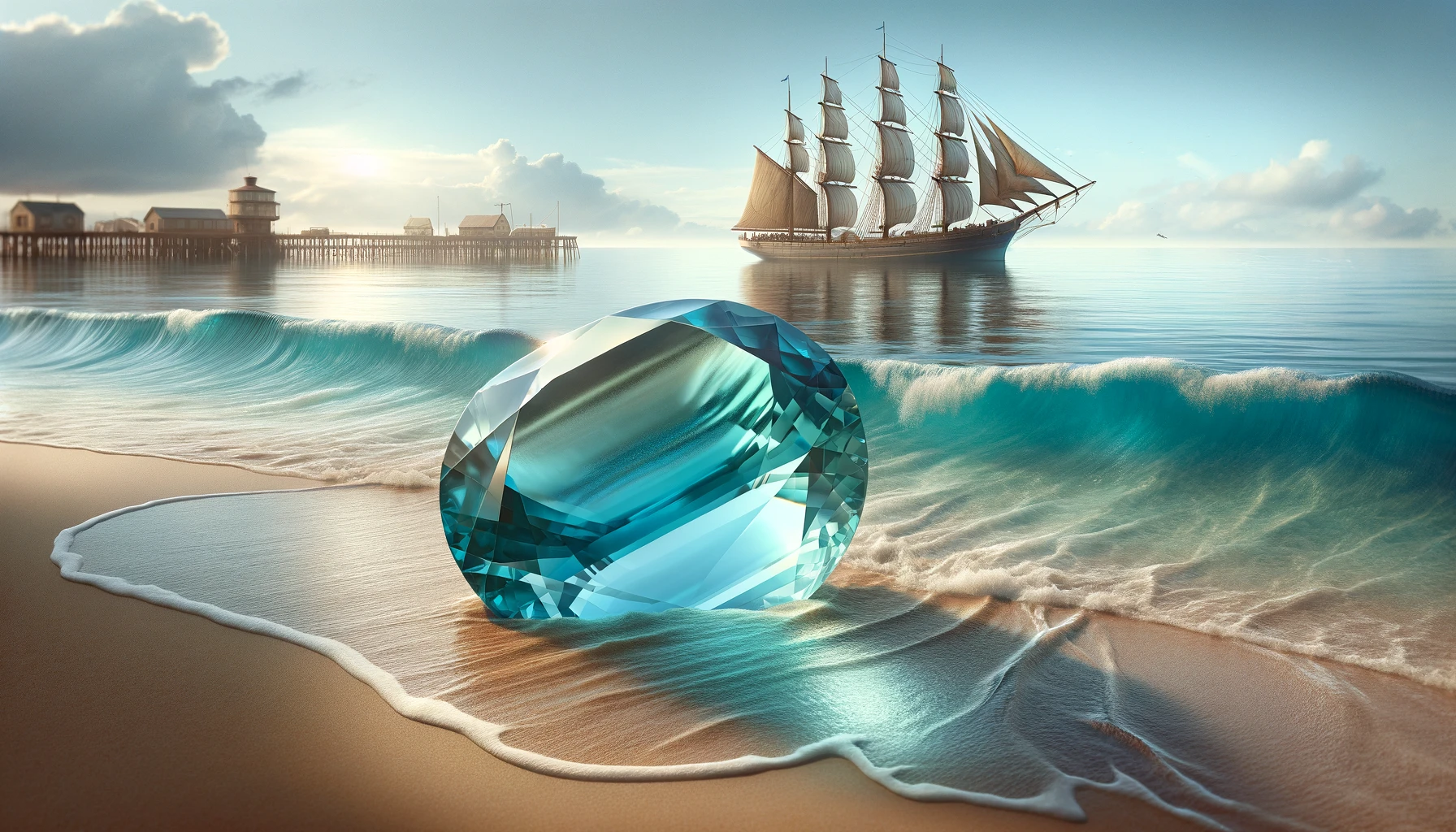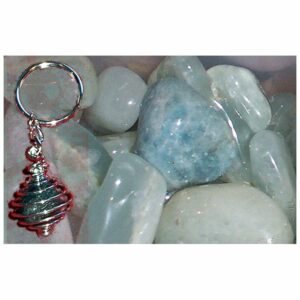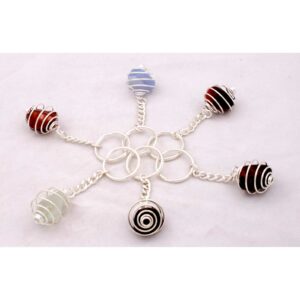March’s Birthstone: Aquamarine is a beautiful gemstone from the Beryl family. People believed that the aquamarine gemstone protected seafarers.
Aquamarine is also the gemstone for the 19th Wedding Anniversary.
Another gemstone associated with March is the Bloodstone.
March also has a flower associated with it which is the Daffodil. As Daffodils bloom in spring they are thought to represent rebirth and new beginnings.
What Colour is Aquamarine?

Aquamarine is most commonly associated with a pale blue or greenish-blue colour, reminiscent of the clear and tranquil waters of the sea. The exact shade of aquamarine can vary, ranging from a light, almost colourless blue to a deeper blue-green hue. The intensity and depth of colour can have an impact on the value and attractiveness of the gemstone. It is important to note that the exact colour of an aquamarine can vary, and gemstones can also exhibit a range of secondary colours such as green, yellow, or even grey.
What Is The History And Symbolism Of March’s Birthstone: Aquamarine?
Aquamarine has a rich history and symbolism as the birthstone for the month of March. The name “aquamarine” is derived from the Latin words “aqua,” meaning water, and “marinus,” meaning of the sea. This gemstone has long been associated with water and the sea, and it was believed to safeguard sailors and ensure a safe journey when worn.
The symbolism of aquamarine extends beyond its association with water. It is said to represent purity, calmness, and tranquillity, evoking feelings of relaxation and peace. The beautiful blue colour of aquamarine is believed to have a soothing effect on the mind and the body, promoting harmony and emotional balance.
Throughout history, aquamarine has been regarded as a symbol of youth, hope, and eternal life. Ancient legends describe aquamarine as a treasure of mermaids, thought to bring good luck and protect against the perils of the sea. In addition, aquamarine is believed to enhance communication, both in speaking and in listening, and to foster feelings of trust and harmony in relationships.
In terms of historical significance, aquamarine has been prized for centuries for its beauty and healing properties. It was used in ancient times as a talisman for its supposed ability to protect against poison and enemies. The ancient Romans believed that aquamarine could purify water when the gem was immersed in it.
What Are The Physical Properties Of Aquamarine?
Aquamarine is a variety of the mineral beryl.
It ranges in colours from pale blue to greenish-blue. The colour is typically caused by traces of iron in the crystal lattice.
Aquamarine is known for its transparency, often appearing clear and without inclusions. However, some specimens may contain minor imperfections or inclusions. Aquamarine exhibits a vitreous or glass-like lustre.
Aquamarine has a hardness of 7.5 to 8 on the Mohs scale, making it a relatively durable gemstone.
Where Does Aquamarine Come From?
Aquamarine is found in various locations around the world. Some of the major sources of aquamarine include Brazil, Nigeria, Madagascar, Zambia, and Mozambique. Brazil is known for producing large quantities of high-quality aquamarine, including the famous Santa Maria aquamarine. Nigeria is also a significant producer of aquamarine, particularly in the Jos Plateau region. Other notable sources include Sri Lanka, Pakistan, Russia, and the United States (specifically Colorado and California).
Aquamarine deposits are generally found in pegmatite veins and granitic rocks. These gemstones are formed in the earth’s crust through the slow crystallization of minerals over millions of years. The specific geological processes that give rise to aquamarine vary from location to location.
Gift Ideas.
-
 Aquamarine Keychain£5.99
Aquamarine Keychain£5.99 -
 Gemstone Key ring Charm£5.99 – £9.95
Gemstone Key ring Charm£5.99 – £9.95
Aquamarine is a wonderful gemstone that makes for beautiful and meaningful gifts. Here are some ideas for aquamarine-inspired gifts:
Aquamarine Jewellery: The most obvious choice is to gift aquamarine jewellery, such as a ring, necklace, bracelet, earrings, cufflinks and tie pins. You could gift a watch with an aquamarine dial.
Aquamarine Crystal or Tumbled Stone: If you’re looking for a more affordable option or something with a metaphysical touch, you can gift aquamarine crystals or tumbled stones. They can be used for meditation, energy healing, or as decorative pieces.
Aquamarine Home Décor: Look for aquamarine-themed home décor items like vases, coasters, or wall art. These can add a touch of elegance and serenity to any space.
Aquamarine-coloured Accessories: If you can’t find or afford real aquamarine, you can still gift accessories in hues similar to aquamarine. Options include scarves, handbags, ties, or even clothing items in shades of blue or green.
Aquamarine-inspired Bath and Beauty Products: Look for bath and beauty products that incorporate the calming and refreshing qualities associated with aquamarine. This can include bath salts, shower gels, or facial mists in blue or green shades.
Remember, the intention and sentiment behind the gift are the most important. Whether you choose a genuine aquamarine piece or something inspired by its colours, the recipient is sure to appreciate the thoughtfulness of the gift.
How To Care And Clean Aquamarine Jewellery
Caring for and cleaning aquamarine jewellery is important to maintain its beauty and ensure its longevity. Here are some tips to care for and clean your aquamarine jewellery:
- Avoid Harsh Chemicals: Keep your aquamarine jewellery away from harsh chemicals, including household cleaning agents, chlorine, and perfumes. These chemicals can damage or discolour the gemstone.
- Remove Jewellery during Activities: Remove your aquamarine jewellery before engaging in activities that may subject it to damage, such as household chores. Aquamarine is relatively durable, but it can still scratch or chip if subjected to impact.
- Store Separately: To prevent scratches store your aquamarine jewellery separately from other jewellery items. You can use soft cloth pouches or individual compartments in a jewellery box to protect them.
- Gentle Cleaning: Use a soft, non-abrasive cloth to gently clean your aquamarine jewellery after each use. This helps remove any dirt or oils that may have accumulated. Avoid using abrasive materials or brushes that may scratch the gemstone.
- Mild Soapy Water: If your aquamarine jewellery needs deeper cleaning, you can use a mild solution of warm water and a few drops of gentle dish soap. Soak the jewellery for a few minutes, then use a soft brush to gently scrub around the gemstone and settings. Rinse thoroughly with clean water and pat dry with a soft cloth.
Remember, each piece of aquamarine jewellery is unique, and care instructions may vary depending on the setting and other gemstones present. When in doubt, consult with a professional jeweller for specific care recommendations for your jewellery.
Final Thoughts
In conclusion, aquamarine is a stunning gemstone and the birthstone for the month of March. Its serene blue-green colour and soothing energy make it a popular choice for jewellery and gifts.
Aquamarine is not only a beautiful gem, but it also holds symbolic meanings of calmness, clarity, and courage. Whether gifted to someone born in March or to anyone who appreciates its tranquil beauty, aquamarine is a thoughtful and cherished choice.
Overall, aquamarine’s intrinsic qualities make it a gemstone that brings joy, elegance, and positive energy to those who wear it.
Please see our blog the colourful world of Birthstones to see what other gemstones are associated with each month



